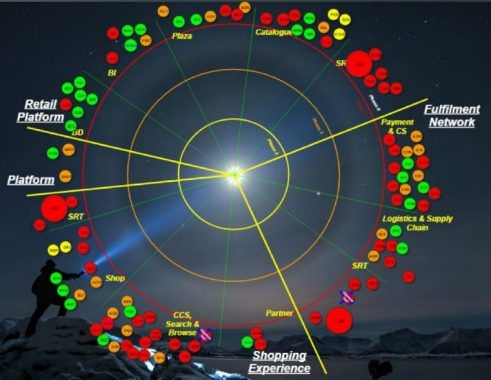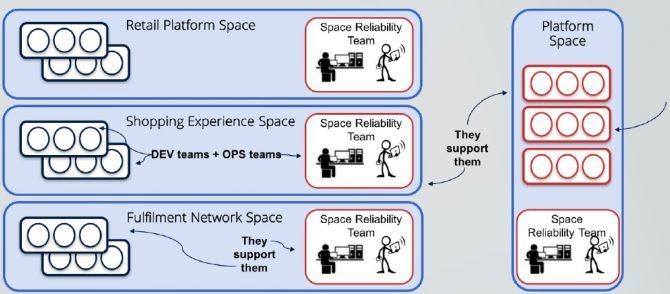Our agile journey so far – Part 2: involving everyone
This is the second post about our growth story. In the first blog post we introduced our Man on the Moon program; how we plan to manage a fast growing company like ours. In this second part we'll explain how we have involved all stakeholders and participants in our journey to the moon. Also, we'll share what has inspired us and how this has helped us to set our own direction.
This post is written by Roy Gielen, an agile enabler who interviewed several persons at bol.com on this topic. We want to thank him for helping us to put our story on paper, making it possible to share our journey with you!
Involving everyone
(by Roy Gielen)
We need to change!
The first step in a change process is to define a sense of urgency. By recognizing at some point that ‘something needs to happen’ to keep enabling growth, innovation and a faster time to market, bol.com defines its sense of urgency. The company believes that ‘autonomy helps to grow the company’, but on the other hand it also experiences that the fast growth could have a negative impact on scalability, productivity and motivation. It is clear that sticking to its current way of working and related processes is not going to work. Extending this way of working would result in more processes, more decision makers and in the end a giant hydrocephalus. There is nothing agile about that anymore, so there’s a need to change radically. And fast! But how?
Who knows what’s best for the company?
According to Kotter, whose eight-steps model is very useful in the process of organizational changes, 'a sense of urgency crafts and uses a significant opportunity as a means for exciting people to sign up to change their organization.' At bol.com they also realize that the change needs to be carried out by its own employees. That's why management at this point decides to share the need for change with its employees. They tell everyone in the company: ‘You are the ones who can make a difference to turn this change into a success.’ This isn’t only necessary to get the employees engaged in the change, but also because the management team recognizes they themselves are not the ones who know what's best for the company.
Get inspired, fail fast, learn and grow!
The management team emphasizes the need for engagement of its employees by telling them that they want to define a strategy together. It’s also clear that they do not believe in a strategy based on big reports and plans or predefined frameworks for agile scaling. Bol.com shows every team the movie created by Spotify: Spotify engineering culture, because the way they work is an example and inspiration for bol.com. With this movie as a starting point they tell all the employees to get inspired by other companies (e.g. in Silicon Valley). Menno Vis, IT director software development at bol.com, tells them ‘to go outside, go visit other companies, join conferences, and 'get inspired and collect bright ideas'.
This approach has multiple advantages:
- employees have a chance to see how others do their daily jobs;
- they can polish and enlarge their external network;
- they get practical tips and tricks about do’s and don’ts;
- people get enthusiastic and motivated to make their own change into a success.
During a certain period ideas are gathered and together they decide which ideas will be tested first.By testing ideas immediately, the people at bol.com experience the applicability in an early stage. The management team gives the employees all the space to ‘fail fast’. They encourage them to come up with ideas and show them that they absolutely will not be punished when things do not work out. If an idea does not work out they share the reason why and learn from it together. All this results in a clear purpose, ambition and strategy.
Define your purpose and ambition
According to John Kotter, ‘having a clear purpose helps you to steer the change effort and develop strategic initiatives to achieve that purpose.’ Creating an autonomous environment and growth in teams is not something that could happen overnight, it’s a complex process. It also needs to be carried out by all the employees. That’s why at bol.com they define a clear purpose and ambition together, which I’ve mentioned in the previous post already: Man on the moon!

The purpose in this phrase is: get a man (bol.com) on the moon. The moon in this case is a metaphor for autonomy. The metaphor for the ambition is the journey itself, it will be a heavy trip: bumpy, complex and unpredictable. It is not only about moving employees to the moon, but also the luggage they carry. Legacy like existing services and applications need to be revised and phased out or moved to the moon. It is important to know that to reach the moon, bol.com wants to travel together with all its employees.
Define a common strategy
To reach the purpose, to move to an autonomous environment and stimulate growth, bol.com also defines a common strategy. One of the first steps in this strategy is to restructure the organization. They stop focusing completely on coordinating and managing and instead decide to build autonomous teams based upon the devops principles. This meant the IT organization was spltted into multiple areas called spaces (e.g. Retail platform space). Every space consists of multiple fleets. A fleet consists of multiple teams which are working in or on the same business domain, each team with its own specific focus. A team is a cross-functional group (with an average of six employees) responsible for a specific part in a space (e.g. search experience). In a space, teams have an end-to-end responsibility for both building, deploying and running 'their' services. Every space has a dedicated space reliability team (SRT) which is responsible for the pavement of the infrastructural road which the fleets will use. The spaces decide what to build, how to build and run it and how to love it. YBIYRIYLI: You build it, your run it, you love it!

Next to the features spaces there is technical platform space who are responsible for bol.com's technical infratructure and associated services. This space is setup in a similar model with teams that are responsible for a specific part in a space. with a focus on supporting the feature spaces.
This new setup also makes it much easier to scale up the organization further. Adding new teams, fleets or even spaces is relatively easy as long as the guiding principles are being followed. A truly scalable organization!
By defining a purpose, ambition and a common strategy together with all the employees, bol.com makes a great step forward. Now it’s not about coordinating and managing anymore, but about autonomous teams with their own responsibilities. To get closer to the moon, spaces and fleets are introduced. In the next blog we will look further into this new process.
About the writer
Roy Gielen is an agile enabler, personal coach and change manager at Ctree BV. He is currently studying for an MBA and writes about successful responsive organizations. Thanks to this combination of skills he guides organizations and their individuals in their journey to responsiveness, keeping in mind that every change starts with the individual. He future proofs organizations so they are ready to adapt in this fast changing world.